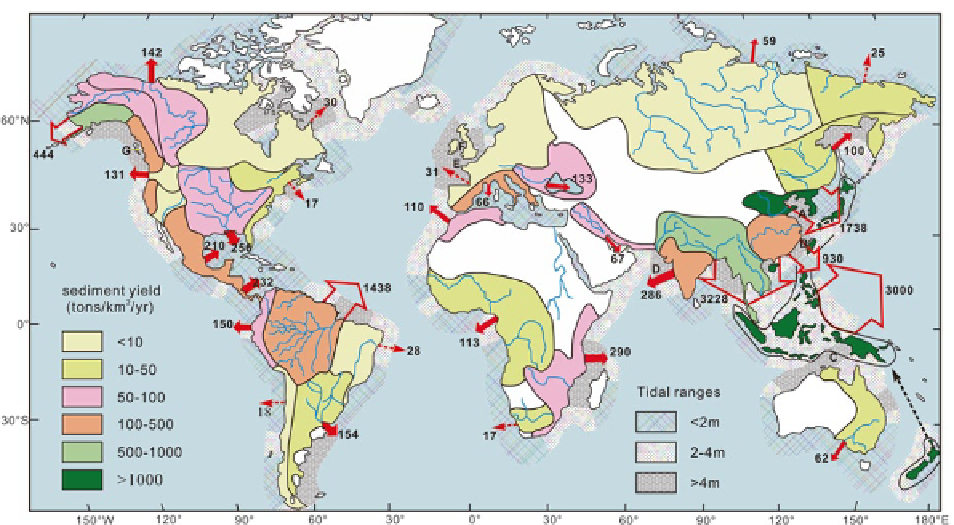Geology Reference
In-Depth Information
Fig. 9.2
Distribution of annual sediment discharge into the sea
(millions of tons per year, modified after Milliman and Meade
1983
; Milliman and Syvitski
1992
) and spring tidal range (m)
along the world's coasts (after Davies
1972
).
A
: Yellow Sea,
B
: Taiwan Strait,
C
: Torres Strait,
D
: Arabian Sea,
E
: English
Channel,
F
: Irish Sea,
G
: Strait of Georgia
Tidal flats are therefore classified into three major types:
(1) back-barrier coast, (2) tide-dominated estuary/delta,
and (3) coastal plain, with increasing wave exposure
from low to high (Figs.
9.1
and
9.5
).
Back-barrier tidal flats are referred to those occupy-
ing the landward side of barrier islands, spits, and bars,
which serve as wave breakers (Fig.
9.5a, b
). The back-
barrier area can be partly occupied by tidal flats like
those in lagoons and wave-dominated estuaries, or
entirely filled with the tidal channel and flat system
like the Wadden Sea. All of them receive limited sedi-
ment input from land. Back-barrier tidal flats typically
develop extensively along the North Sea coast, and the
Atlantic coast of Europe and North America (Flemming,
Chap. 10 in this volume), which are both trailing edge
coast receiving limited fluvial sediment input. They can
also develop along the leading edge coast receiving
abundant sediment like the Pacific US coast (e.g.,
Alaska and North California).
Tidal flats fringing the tide-dominated estuaries/
deltas have varied magnitudes of wave exposure. Those
are generally exempted from wave influence in the inner-
most part of the estuarine-deltaic system or in the estu-
aries having a guard (bottle-neck) shape (Fig.
9.5c
).
The outer part of the open-mouth estuaries and deltas
are subject to wave impacts, especially during storm
seasons (Fig.
9.5d-f
). For example, wave influence is
generally absent for the tidal flats in the inner part of the
Xiangshan Bay deeply cutting into the land and Sanmeng
Bay, while it gradually increases toward the baymouth.
The straight coast of the highly filled Jiaojiang Estuary
is completely open to the sea in the Zhejiang Province,
central east of China (Fig.
9.6
). In general, small river
estuaries of tide domination usually foster sandy tidal
flats because of limited fine sediment input from the
rivers, except those receiving large volume of fine-
grained sediment from the adjacent mega-river deltas by
alongshore transport, like the estuaries along the
Zhejiang coast nourished by Changjiang-sourced sedi-
ment (Figs.
9.3
and
9.6
). Therefore, sandy estuarine and
strand plain tidal flats are commonly distributed along
the coast of islands or peninsulas enclosing a broad and
shallow strait or epeiric sea, where fine-grained sedi-
ment is generally exempted and macrotide is highly
favorable owing to the morphological amplification,
like the Yellow Sea, the Taiwan Strait, the Torres Strait,
the Arabian Sea, the English Channel, the Irish Sea, the
Strait of Georgia, and so on (Fig.
9.2
).

